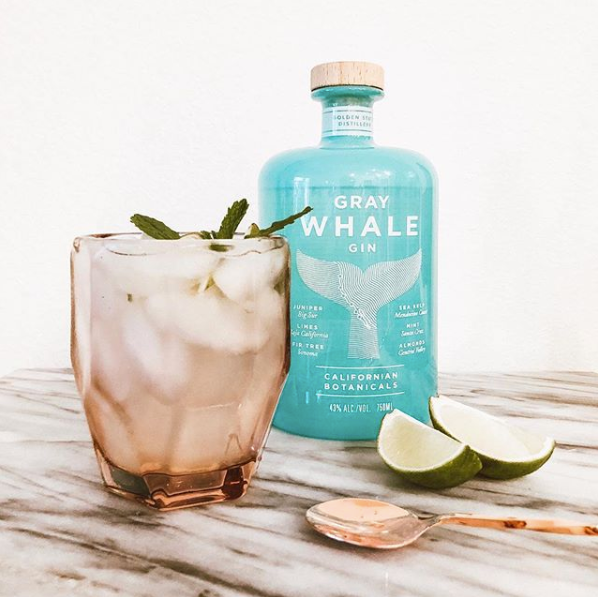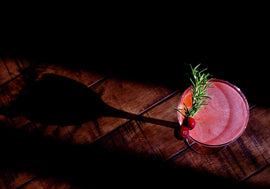Gray Whale Gin
Thankfully, Gin has shed its image as the degenerative scourge of 18th century England, and today has become a highly prized champion of the craft spirit revolution. Tristan Stephenson in his book Gin Palace writes, “…and there’s a new breed of gin drinker whose preconceptions have been squashed like a wedge of lime. Pronounced flavor, credible provenance, botanical terroir and innovative packaging are just some of the considerations that drive modern gin drinkers to buy one brand over another. This isn’t just a renaissance of gin that we are experiencing right now—it’s gin’s golden time.” The freedom that novelty offers has given gin makers the opportunity to delve into new realms of gin possibilities, from state of the art extraction technology to innovative means of large-scale production.
Distiller/company founder, chef, and culinary TV personality Marsh Mokhtari had a vision of a spirit that reflected his own reverence for the Pacific Ocean and the gentle giant that inhabits its waters. Using the gray whale as his inspiration, he set out to make a one of a kind London Dry style gin that also exhibited the wonderful bounties of the great State of California. Gray Whale Gin is the first product from Golden State Distillery, which launched its first release in October of 2016.
The bottle, the logo, and packaging, designed by Jan Livingston (Mokhtari’s wife), design agency United Creatives, and Global Packaging LLC represent the couple’s commitment to organic, sustainable, and renewable sourcing. The blue paint on the bottle is organic and eco-friendly, and the real cork closure is biodegradable. Sustainability and protecting the world’s oceans are among the core values of Mohktari and Gray Whale. In fact, the brand supports Oceana—a nonprofit that works to protect and restore the world’s oceans—and is 1% for Planet certified, meaning they contribute at least one percent of their annual sales to environmental causes.
Gray Whale’s bottle has horizontal lines making up the left of the tail that conjure images of ocean waves. The vertical lines represent more than 800 miles of coastline in California and Baja California. Gray whales begin their lives in Baja California and eventually migrate north to feed and breed. Six dots placed along the vertical lines represent both the gray whale journey and the locations from which Golden State Distillery sources their botanicals for the Gray Whale Gin. The journey starts from the bottom dot. Gray whales are birthed in Baja California, which is also where the limes are sourced from an organic farm. Next comes juniper from Big Sur and mint from Santa Cruz. Then the Central Valley, where Gray Whale gets almonds. California is the world’s largest producer of almonds that imbue this gin with a creamy mouthfeel. The tops of fir trees come from Sonoma, and an edible sea kelp known as kombu (which imparts umami flavor) is from the Mendocino Coast.
Gray Whale Gin is distilled on a Carl 2000-liter hybrid pot and column still. They distill their corn-based spirit six times creating an ultra-premium pure base. They then distill one last time with all of their botanicals in a one-shot, London dry style. All of the dried botanicals, the Juniper, Kombu and almonds go directly into the liquid into the pot still. All fresh botanicals, the lemons, limes, oranges, mint and fir needles go into a vapor extraction bag that is housed directly in the helmet of the pot still, giving a much more delicate extraction of those fresh botanicals. The result is a remarkably balanced gin. Aromas of fresh citrus, peppery and herbaceous juniper, and the distinctive yet subtle piney scent of fir jump out of the bottle. On the tongue, lively, bright, lime and mint flavors give way to a hint of umami, complimented by the long, smooth and subtle finish of almonds. The mouthfeel itself is creamy and pleasant. Excellent as a stand-alone Martini, it carries its flavors well when incorporated into a mixed cocktail.
Rhubarb-Fennel Gin Cocktail
Ingredients:
¼ fennel bulb, untrimmed, coarsely chopped
1 375-ml bottle dry vermouth (preferably Dolin)
1 large rhubarb stalk, thinly sliced, plus more, shaved, for serving
½ cup sugar
¾ cup fresh lemon juice
¾ cup gin (preferably Fords)
Combine fennel and vermouth in a glass container (save vermouth bottle). Cover and chill 2 days. Strain through a fine-mesh sieve back into bottle.
Bring rhubarb, sugar, and ½ cup water to a gentle simmer in a small saucepan over medium heat and cook until mixture is pink and slightly syrupy, 14–16 minutes. Let cool, then transfer to a blender and purée until smooth (you should have about ½ cup rhubarb purée).
Combine 12 oz. fennel-infused vermouth, rhubarb purée, lemon juice, gin, and 2 cups ice in a large pitcher. Stir until cold. Pour cocktail into ice-filled old-fashioned glasses and garnish with shaved rhubarb.
Cucumber Gin Cocktail
Ingredients:
1 cucumber
5 kaffir lime leaves or four 2-inch strips lime zest
2 teaspoons raw sugar
4 lemon wheels, divided
4 ounces gin
1 ounce fresh lime juice
Club soda (for serving)
Using a vegetable peeler, shave 4 long, thin ribbons from cucumber; set aside. Cut a 4" piece from remaining cucumber and coarsely chop. Muddle with kaffir lime leaves, sugar, and 2 lemon slices in a cocktail shaker. Add gin and lime juice and fill shaker with ice. Cover and shake until outside of shaker is frosty, about 20 seconds.
Strain into 2 ice-filled Collins glasses. Top off each with club soda. Gently stir to combine; garnish each with 2 reserved cucumber ribbons and remaining lemon slices.
Vesper
Ingredients:
1½ ounces gin
1 ounce vodka
½ ounce Lillet Blanc
1 lemon
Stir gin, vodka, and Lillet Blanc in an ice-filled mixing glass until very cold, about 30 seconds. Strain cocktail through a Hawthorne strainer or a slotted spoon into a martini glass.
Using a small serrated knife, remove a 1" strip of peel from lemon (some white pith is okay); it should be stiff enough to provide some resistance when bent. Twist over drink to express oils; discard. Garnish with a lemon twist.
Cover Photo: @graywhalegin





